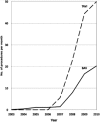Percutaneous balloon aortic valvuloplasty in the era of transcatheter aortic valve implantation: a narrative review
- PMID: 28008354
- PMCID: PMC5174794
- DOI: 10.1136/openhrt-2016-000421
Percutaneous balloon aortic valvuloplasty in the era of transcatheter aortic valve implantation: a narrative review
Abstract
The role of percutaneous balloon aortic valvuloplasty (BAV) in the management of severe symptomatic aortic stenosis has come under the spotlight following the development of the transcatheter aortic valve implantation (TAVI) technique. Previous indications for BAV were limited to symptom palliation and as a bridge to definitive therapy for patients undergoing conventional surgical aortic valve replacement (AVR). In the TAVI era, BAV may also be undertaken to assess the 'therapeutic response' of a reduction in aortic gradient in borderline patients often with multiple comorbidities, to assess symptomatic improvement prior to consideration of definitive TAVI intervention. This narrative review aims to update the reader on the current indications and practical techniques involved in undertaking a BAV procedure. In addition, a summary of the haemodynamic and clinical outcomes, as well as the frequently encountered procedural complications is presented for BAV procedures conducted during both the pre-TAVI and post-TAVI era.
Keywords: INTERVENTIONAL CARDIOLOGY.
Conflict of interest statement
Conflicts of Interest: None declared.
Figures



Similar articles
-
Contemporary use of balloon aortic valvuloplasty in the era of transcatheter aortic valve implantation.Tex Heart Inst J. 2014 Oct 1;41(5):469-76. doi: 10.14503/THIJ-13-3757. eCollection 2014 Oct. Tex Heart Inst J. 2014. PMID: 25425977 Free PMC article.
-
Utility of balloon aortic valvuloplasty in the transcatheter aortic valve implantation era.Open Heart. 2020 Apr;7(1):e001208. doi: 10.1136/openhrt-2019-001208. Open Heart. 2020. PMID: 32341170 Free PMC article.
-
Balloon Aortic Valvuloplasty in the Transcatheter Valve Era: Single Centre Indications and Early Safety Data in a High Risk Population.Heart Lung Circ. 2018 May;27(5):595-600. doi: 10.1016/j.hlc.2017.05.128. Epub 2017 Jun 2. Heart Lung Circ. 2018. PMID: 28688833
-
Contemporary balloon aortic valvuloplasty: Changing indications and refined technique.Catheter Cardiovasc Interv. 2021 Jun 1;97(7):E1033-E1042. doi: 10.1002/ccd.28807. Epub 2020 Feb 25. Catheter Cardiovasc Interv. 2021. PMID: 32096927 Review.
-
Balloon aortic valvuloplasty as a bridge to aortic valve surgery for severe aortic stenosis.Interact Cardiovasc Thorac Surg. 2015 Mar;20(3):429-35. doi: 10.1093/icvts/ivu398. Epub 2014 Dec 8. Interact Cardiovasc Thorac Surg. 2015. PMID: 25487231 Review.
Cited by
-
Clinical Outcomes of a Non-Compliant Balloon Dilatation Catheter: MOZEC™ NC Study.Int J Environ Res Public Health. 2022 Dec 4;19(23):16231. doi: 10.3390/ijerph192316231. Int J Environ Res Public Health. 2022. PMID: 36498303 Free PMC article.
-
Retrograde balloon aortic valvuloplasty with the newly invented Inoue balloon for aortic stenosis accompanied by severe heart failure: A case report.Clin Case Rep. 2021 Feb 12;9(4):2011-2015. doi: 10.1002/ccr3.3928. eCollection 2021 Apr. Clin Case Rep. 2021. PMID: 33936631 Free PMC article.
-
The use of semi-compliant versus non-compliant balloon systems for predilatation during the implantation of self-expandable transcatheter aortic valves: Data from the VIenna CardioThOracic Aortic Valve RegistrY (VICTORY).Eur J Clin Invest. 2021 Sep;51(9):e13570. doi: 10.1111/eci.13570. Epub 2021 May 6. Eur J Clin Invest. 2021. PMID: 33954997 Free PMC article.
-
Use and Outcomes of Acute Treatment Strategies in Patients with Severe Aortic Valve Stenosis.Glob Heart. 2021 Dec 27;16(1):91. doi: 10.5334/gh.1055. eCollection 2021. Glob Heart. 2021. PMID: 35141132 Free PMC article.
-
Ultrasound-Guided Percutaneous Balloon Aortic Valvuloplasty for Aortic Stenosis.J Interv Cardiol. 2020 Mar 16;2020:8086796. doi: 10.1155/2020/8086796. eCollection 2020. J Interv Cardiol. 2020. PMID: 32256250 Free PMC article.
References
-
- Cribier A, Savin T, Saoudi N et al. . [Percutaneous transluminal aortic valvuloplasty using a balloon catheter. A new therapeutic option in aortic stenosis in the elderly]. Arch Mal Coeur Vaiss 1986;79:1678–86. - PubMed
-
- Cribier A, Eltchaninoff H, Bash A et al. . Percutaneous transcatheter implantation of an aortic valve prosthesis for calcific aortic stenosis: first human case description. Circulation 2002;106:3006–8. - PubMed
-
- Kapadia SR, Leon MB, Makkar RR et al. . 5-year outcomes of transcatheter aortic valve replacement compared with standard treatment for patients with inoperable aortic stenosis (PARTNER 1): a randomised controlled trial. Lancet 2015;385:2485–91. - PubMed
LinkOut - more resources
Full Text Sources
Other Literature Sources
